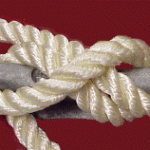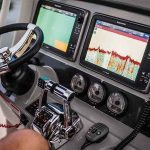So you have some time on your hands, and you figure you’ll just go hang out down at the marina where “she” sits patiently waiting for you at a pier or mooring buoy. Or maybe she’s just outside your door, sitting on a trailer in the garage or driveway, and you decide to spend some time with her. Although we all seem to have less discretionary time than we used to, there are occasions when we feel like spending some of it with our boats, quietly and intimately. Next time you’re in that kind of mood, take full advantage of your visit. Before you go, throw a few things into a small box. You’ll need:
A pencil and small notebook
A screwdriver set and ratchet set
Your engine owner’s manual
Your electronics and gadget manuals
A few toothpicks
A small sheet of emery paper
Here’s the plan:
1. Walk around the boat, tightening every screw and bolt and nut you can see. You’ll be surprised how many of them are loose. The pounding of a boat running across the water, or bouncing on a trailer, really can loosen up the hardware. (And speaking of trailers, you’ll want to check and tighten those bolts, too.) On the boat, pay close attention to the bolts that hold your rails and cleats to the hull. They should be bolted through the hull and hardwood or metal back-plated. If they’re not, make that a priority project for your next visit. And here’s a neat tip – if you find any screws that go into wood and they won’t turn down tightly, break a few toothpicks into little pieces and shove the pieces into the screw hole. Now push the screw into the hole containing the little toothpick bits and tighten it down. You’ll find it’s as tight or tighter than it was when it was new.
2. Find everything in the boat that’s battery operated, and turn them on. Jot down in your notebook the size and number of batteries each device requires, and which ones need replacement batteries. If the device is rechargeable, note that, too, and whether it needs recharging. In addition to all the clocks and flashlights, don’t forget your handheld GPS and portable VHF radio. Then, next time you visit, you can bring fresh batteries to get everything back to life. It’s a great comfort knowing that when you need that flashlight to light, it will.
3. Take all your navigation light bulbs out of their sockets and clean the metal part of the bulb and inside of the socket with the emery paper. For the latter, just roll the paper loosely, gritty side out, and give it a few twists inside the socket. Then, after cleaning each one, take out the trusty notebook and pencil and note the description of the light and the bulb. On your return visit, you can bring a couple spare bulbs for each light socket, and have the peace of mind that if the lights burn out in a heavy traffic area at night, you will have a handy spare and already will have practiced how to remove and replace the bulb quickly and easily. And one more thing. While you have the nav light lenses off, clean them, but be sure to replace them correctly. (You know – red lens to port, green lens to starboard.)
4. Visit with your electronics. It doesn’t matter if you see your Loran as a toy or as a serious navigational aid. If you have it, you should know how to use it. Have you ever taken the time to review all the functions of your radar or GPS or depth sounder? You’re going to be surprised at all the things these devices can do that you didn’t know about. You paid for all the functions, not just a few of them. Sit down in front of each instrument, open the manual that came in the box with the device, and go through it page by page, punching up all the functions and seeing what marvels they hold.
5. Finally, sit down, relax and develop a meaningful relationship with your engine. Sit in front of it with your engine owner’s manual, and see if you can locate some of the parts that you are likely to be fiddling with before your boating days are over. For example, see if you can find the fuel filter. After you find the fuel filter, read the manual to see how you remove and replace it. Determine where other critical fuel and electrical parts are located, and try to imagine a failure in one of those parts and what you might do to repair or do a work-around that would get you back into port. Unless you’re a commercial engineer, you obviously aren’t going to do a major overhaul or change a cracked piston. But you’ll be surprised at what you can do if your engine overheats or quits from fuel starvation, just by spending some time with your manual and that inboard or outboard or diesel engine.
So, if you’ve got some spare time, and you want to spend it with her, show her how much you care. Keep her shipshape, learn all about her, and you’ll improve the chances that your relationship with your boat will last for many trouble-free years to come.








